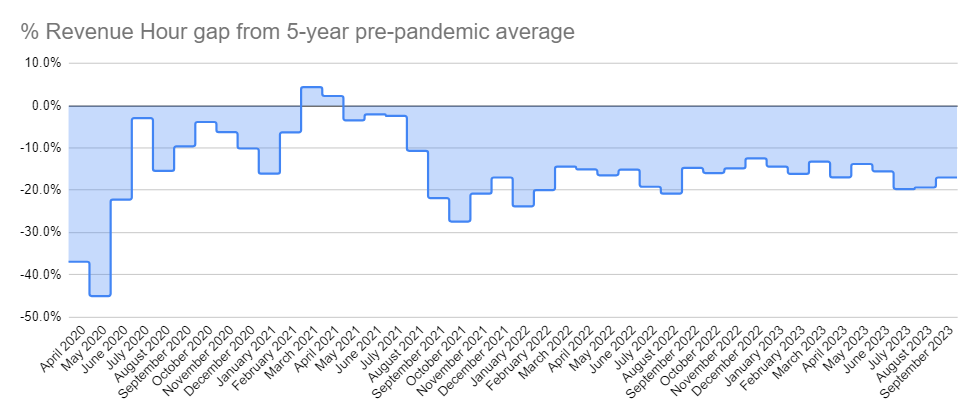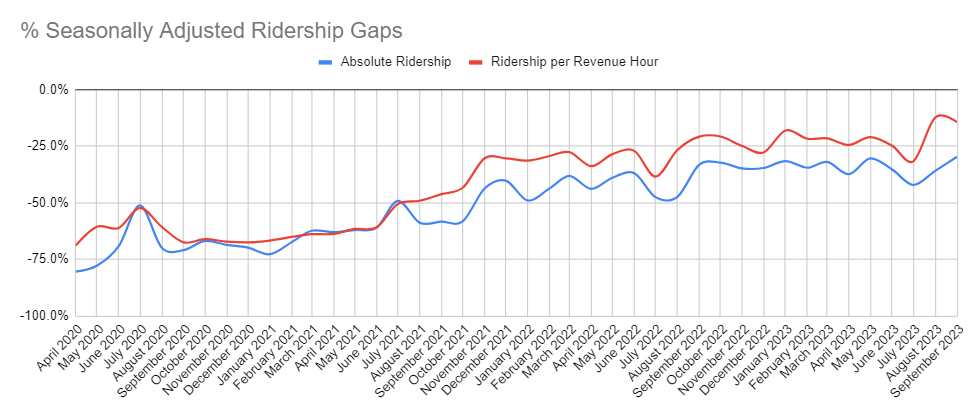More people rode a Centro bus in September 2023 than in any month since October 2019. That marks the first time post-pandemic monthly transit ridership in Syracuse has exceeded any pre-pandemic mark.
This is good news for Centro, but the ridership trends leading up to September tell a slightly more complicated story about the state of transit in Syracuse. We still have a ways to go just to get back to our pre-pandemic (and barely adequate) status quo, but Centro is changing its service in ways that put them on the path to providing the quality transit service Syracuse needs and deserves.


In the five years leading up to the pandemic, Centro’s monthly ridership averaged about 850,000. In the first months of lockdown, ridership dropped to about 200,000. Ridership has grown steadily—with allowances for seasonal variation—since then. Every single month since April 2021 has seen higher ridership than the same month of the previous year, and in September 2023, monthly ridership hit 857,415—higher than the pre-pandemic average, and the highest monthly total since October 2019.


However, Centro’s monthly ridership follows a pretty regular cycle, and September has always been the highest ridership month of the year (the NYS Fair and the beginning of the academic year both bring a lot of riders). In the five years before the pandemic, average September ridership was just over 1,200,000, so if we’re comparing apples-to-apples, September 2023’s ridership was 30% below the pre-pandemic norm. That’s still smaller than any other post-pandemic month’s seasonally adjusted gap (or, the percentage difference between current ridership and the average ridership for that same month in the five years preceding the pandemic), but it’s far from a full recovery.


It’s not totally fair to compare today’s absolute ridership to pre-pandemic months, though, because Centro has fewer buses on the streets than they used to. Ever since the Summer of 2021, Centro has not been able to hire enough operators to run its regular service. Revenue hours (the total amount of time Centro buses are available to riders) are consistently 1/8 to 1/5 below the pre-pandemic norm, and that decrease in service has depressed total ridership. Better to compare ridership per revenue hour (a measure of transit efficiency) to get a sense of how much the service is being used. That measure shows September 2023 at just 14% below the pre-pandemic norm.
Ridership per revenue hour has outperformed total ridership because Centro has focused its scarce resources on high-ridership routes. When the staffing crisis hit, the first service cuts came from low-ridership lines. That allowed Centro to preserve more service on higher-performing lines through populous neighborhoods. If Centro had simply cut service evenly across the board, today’s total ridership would be even lower.
The same logic should guide Centro’s approach to its network redesign: enhance service in the places where people ride the bus most to get the biggest increases in ridership.

Centro still has a ways to go to get ridership back where is was before March of 2020. It has even farther to go to provide Syracuse with the kind of transit service we really need. But the system’s steady recovery, and Centro’s commitment to focusing resources where they’ll do the most good, gives hope that they’re on the right path.
